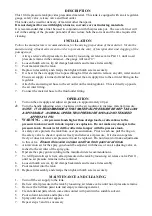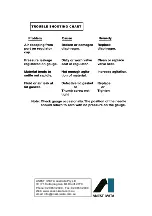
DESCRIPTION
This 10 litre pressure tank provides pressurized material. This tank is equipped with an air regulator,
gauge, safety valve, release valve and fluid outlet.
This tank can be used for delivery of material other than paint.
It is not designed for use with highly abrasive, corrosive or rust inducing materials.
It is recommended that a liner be used in conjunction with this pressure pot. The use of a liner will
aid in the sealing of the pressure pot and will also reduce both the solvent and the time required for
cleaning.
INSTALLATION
Follow the manufacturers recommendations for the mixing preparation of the material. Strain the
material using a fine mesh screen in order to prevent the entry of foreign matter and clogging of the
passageways.
1.
Always relieve all air pressure in the tank by loosening air release valve Part 11, until no air
pressure remains in the container—the gauge will read ‘0”.
2.
Loosen thumb screws, tip lid clamps backwards and remove lid assembly.
3.
Pour material into the tank.
4.
Replace lid assembly and clamps then tighten thumb screws securely.
5.
It is best for the air supply line to pass through a filter element to remove any dirt, water and oil.
Ensure air supply is turned off and then connect the air supply line to the air inlet fitting on the
regulator.
6.
Attach the atomizing air hose to the air outlet on the tank regulator. This is directly opposite
the air inlet fitting.
7.
Connect the material hose to the fluid outlet fitting.
OPERATION
1.
Turn on the air supply and adjust air pressure to approximately 40 psi.
2.
Turn the handle adjusting screw clockwise on the air regulator to increase material pressure.
NOTE: IT IS RECOMMENDED THAT MATERIAL PRESSURE BE KEPT AS LOW
AS POSSIBLE - NORMAL OPERATING PRESSURE SHOULD NOT EXCEED
APPROX 15 PSI.
3.
WARNING -
Air pressure loads higher than design loads, or alterations to the
pressure tank can result in tank rupture or explosion. Do not make any changes to the
pressure tank. Do not weld, drill or otherwise tamper with the pressure tank.
4.
A safety valve protects the tank from over pressurization. Prior to each use pull the ring on
the safety valve to check it operates freely and relieves air pressure. If it does not operate
freely or does not relieve air pressure it must be replaced. Do not discard or make adjustments
to this valve.
Ensure this valve is clean and free from paint at all times
5.
Atomization air for the spray gun should be adjusted with the use of an air adjusting valve at-
tached to the air inlet of the spray gun.
6.
Operate the spray gun according to the manufacturers recommendations..
7.
To refill paint always relieve all air pressure in the tank by loosening air release valve Part 11,
until no air pressure remains in the container.
8.
Loosen thumb screws, tip lid clamps backwards and remove lid assembly.
9.
Pour material into the tank.
10. Replace lid assembly and clamps then tighten thumb screws securely.
MAINTENANCE AND CLEANING
1.
Turn off the air supply to the tank.
2.
Relieve all air pressure in the tank by loosening air release valve until no air pressure remains.
3.
Remove the lid from paint tank and empty remaining material.
4.
Clean tank and parts which come into contact with paint with a suitable solvent.
5.
Pour solvent into tank and replace lid.
6.
Spray until clean solvent appears.
7.
Repeat steps 3 and 4 as necessary.
Содержание PT.10
Страница 1: ...PT 10 Instruction Manual February 2018 ...






















